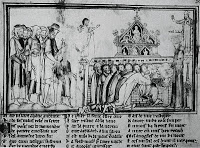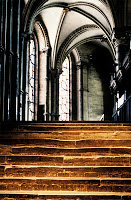Medieval History
I'm sketching out a short essay for Literature Compass on teaching things medieval in the modern world, specifically on teaching a culture of (medieval) belief within a culture of (modern) secularity. I'll be talking about three main points of resistance that students most often bring to the study of the Middle Ages: "An Aversion to Fervor" (dismissing the passion for miracles or legends as childlike belief - relics is the hot button issue here); "That's Not My God" (not recognizing the character of a divine they think unchanging - Christ as the romantic, sensual Lover of the Soul in the Song of Songs really brings this out); and "Mistakes Were Made" (shrugging off the entire period as long past and mistaken - a conviction fed by 18th/19th century inventions such as the chastity belt). The point, to my mind, is not to demonstrate the maturity and gravitas of medieval belief, or that God/Christ was more revelatory in the Middle Ages, or that the Middle Ages were right somehow, but rather to present strategies that seek to get students past a safe dismissal of the period, and moving towards a more challenging interpretation of its phenomena. One strategy that I will not argue for is that of bringing in the gravitas and complexity of medieval theology to quell students' doubts and hesitations about the worthiness (gravitas and complexity) of the period. This was the tried and true strategy in art history until the 1980s and Michael Camille (and thus why to this day the absolutely overwhelming majority of medieval art historical scholarship still focuses on religious art). The study of the Middle Ages can, and indeed must, appeal intellectually to students who are not initiated into its theology.
Enter the strategy of comparing behaviors. [Geez that sounds facile when I put it like that. (Maybe I should drop the "geez"). My anxieties about publishing anything-not-in-an-anthology are pathetically debilitating - ack!] - of comparing behaviors not to say "we are all the same," or "we are no better than the Middle Ages" (though the shock value of the latter statement has proven effective in shaking the complacency that we here and now live in the best of all possible worlds, or that our world needs no improvement), but rather to examine the conditions of possibility for both responses, to try and understand what's motivating and driving the actors in both scenarios. This is why in teaching relics and reliquaries I introduce the idea of the belief in the power/currency of saints' bones by asking a student if I may tear up his or her $20 bill. Of course I can't - why not? Because we somehow believe that that piece of paper, inked in that particular way, is worth something. And so the interest in the class discussion becomes "how materials of intrinsic non-worth come to have worth" instead of "medieval people were naïve for believing that old bones were worth something" (it's actually really helpful in teaching art period, and I never cease to marvel that paint and canvas, or bits of stone have come to mean so much).
And so at the end of a really swell Thanksgiving holiday which included hiking and movies and reading and talking with the kids, and talking about Egypt and California and protests and pepper spray and violence with the adults, I am left wondering about footage like the one I invite you to view below. Medieval pilgrims and their fervor tend to unsettle students. Perfect, let's bring that to Thanksgiving, its talk of pilgrims, and the modern incarnation of a fervent rush.
I am fascinated watching that crowd surge. It's not the secular, rational, controlled world I live in, and I'd never ever put myself there. But there's something satisfying in watching that powerful flow of people (maybe to compensate for all the crowds crushed by authoritarian regimes of late?). It's easy, as the commentators do, to dismiss their fervor as stupid and naïve, but they exist and they are driven and they are interconnected (by love of family, and pull of objects, and hope of connection and yes, even happiness) - and we should be asking why and how, for then and now.
This essay will be fun to write and I've hopefully exorcised some of my yet/but/though side-stepping here (with apologies to you, dear reader!). I think that at the bottom of this comparative approach of popular cultures is my own resistance to the higher orders of culture determining worth. Why not take fervor seriously and ask whence its conviction and where to its reach? Why not discuss the irrational that exists outside of academic discourse within the rational discourse of the classroom? Popular belief, in its messiness and poignancy and excess, has its own gravitas: just ask the stone steps of Canterbury Cathedral leading up to Becket's shrine, worn smooth and rubbed away by the fervent ascent of pilgrims.
- Accessible Pasts
Late last night, I saw this marvelous link floating around the interwebs: a digitized version of Cotton Nero A.x, or, the Pearl-manuscript. It's a wonderful thing to behold, and potentially so useful. Not only can we, as scholars of medieval...
- Blogging, Tweeting, And Publishing
I've been asked by JJ Cohen of In the Middle to compose something on the creation of my blog and my adventures in tweeting for an article he's working on. The article will appear in a book centered around Geoffrey Chaucer hath a Blog, in...
- Pilgrim's Progress
St. Aemilion. 1060, ivory. The Met.I've struggled with this before and will again: was there an operative concept of social progress in the Middle Ages? with its necessary preconditions that there are grave injustices that need to be righted?...
- Medieval Afterlives In Popular Culture
Medieval Afterlives in Popular Culture, expertly edited by Gail Ashton and Daniel T. Kline, has now been published in Palgrave's The New Middle Ages Series. Drawing from an eclectic mix of scholars from the US, UK, and Australia, Medieval...
- Interviews, Part Ii
As part of my interviews for this blog, I asked my friend Elliott who is currently working on his doctorate. When it comes to medieval art (or art history in general) I don't think I've met anyone with a greater passion. As you will see, he is...
Medieval History
Black Friday Pilgrims
 |
| Pilgrims at St. Edwards' Tomb |
Enter the strategy of comparing behaviors. [Geez that sounds facile when I put it like that. (Maybe I should drop the "geez"). My anxieties about publishing anything-not-in-an-anthology are pathetically debilitating - ack!] - of comparing behaviors not to say "we are all the same," or "we are no better than the Middle Ages" (though the shock value of the latter statement has proven effective in shaking the complacency that we here and now live in the best of all possible worlds, or that our world needs no improvement), but rather to examine the conditions of possibility for both responses, to try and understand what's motivating and driving the actors in both scenarios. This is why in teaching relics and reliquaries I introduce the idea of the belief in the power/currency of saints' bones by asking a student if I may tear up his or her $20 bill. Of course I can't - why not? Because we somehow believe that that piece of paper, inked in that particular way, is worth something. And so the interest in the class discussion becomes "how materials of intrinsic non-worth come to have worth" instead of "medieval people were naïve for believing that old bones were worth something" (it's actually really helpful in teaching art period, and I never cease to marvel that paint and canvas, or bits of stone have come to mean so much).
And so at the end of a really swell Thanksgiving holiday which included hiking and movies and reading and talking with the kids, and talking about Egypt and California and protests and pepper spray and violence with the adults, I am left wondering about footage like the one I invite you to view below. Medieval pilgrims and their fervor tend to unsettle students. Perfect, let's bring that to Thanksgiving, its talk of pilgrims, and the modern incarnation of a fervent rush.
I am fascinated watching that crowd surge. It's not the secular, rational, controlled world I live in, and I'd never ever put myself there. But there's something satisfying in watching that powerful flow of people (maybe to compensate for all the crowds crushed by authoritarian regimes of late?). It's easy, as the commentators do, to dismiss their fervor as stupid and naïve, but they exist and they are driven and they are interconnected (by love of family, and pull of objects, and hope of connection and yes, even happiness) - and we should be asking why and how, for then and now.
 |
| Pilgrim Steps at Canterbury |
- Accessible Pasts
Late last night, I saw this marvelous link floating around the interwebs: a digitized version of Cotton Nero A.x, or, the Pearl-manuscript. It's a wonderful thing to behold, and potentially so useful. Not only can we, as scholars of medieval...
- Blogging, Tweeting, And Publishing
I've been asked by JJ Cohen of In the Middle to compose something on the creation of my blog and my adventures in tweeting for an article he's working on. The article will appear in a book centered around Geoffrey Chaucer hath a Blog, in...
- Pilgrim's Progress
St. Aemilion. 1060, ivory. The Met.I've struggled with this before and will again: was there an operative concept of social progress in the Middle Ages? with its necessary preconditions that there are grave injustices that need to be righted?...
- Medieval Afterlives In Popular Culture
Medieval Afterlives in Popular Culture, expertly edited by Gail Ashton and Daniel T. Kline, has now been published in Palgrave's The New Middle Ages Series. Drawing from an eclectic mix of scholars from the US, UK, and Australia, Medieval...
- Interviews, Part Ii
As part of my interviews for this blog, I asked my friend Elliott who is currently working on his doctorate. When it comes to medieval art (or art history in general) I don't think I've met anyone with a greater passion. As you will see, he is...
